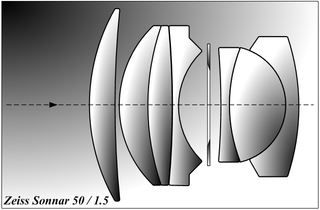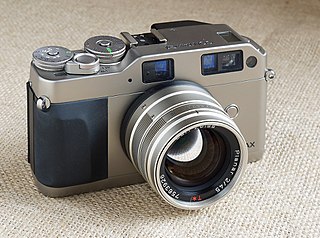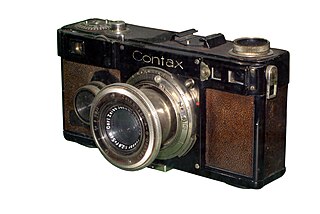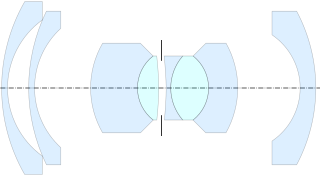 | |
| Overview | |
|---|---|
| Type | 35mm rangefinder camera |
| Lens | |
| Lens mount | Tenax bayonet |
During the 1930s, Zeiss Ikon (ZI) made a wide range of miniature cameras for the 35mm film format. Most cameras used the standard 24×36 mm frame size, like the Contax, Nettax and Super Nettel. However, the ability to take images in fast sequence was a popular marketing element at the time, and several fast-operating models were made. Among these were the Otto Berning's motor-driven Robot cameras as well as the ZI lever-operated Tenax I and Tenax II. These have the smaller square format of 24×24 mm, enhancing faster frame advance. [1]
When still cameras using 35 mm film, originally used for cinematography, were introduced they were widely known as miniature cameras to distinguish them from the then commonplace rollfilm cameras. While the term could be used for a camera larger than a subminiature and smaller than a rollfilm camera, it was mostly used for cameras taking 135 film cassettes, or other 35 mm cassettes.

135 is photographic film in a film format used for still photography. It is a cartridge film with a film gauge of 35 mm (1.4 in), typically used for hand-held photography in 35 mm film cameras. Its engineering standard for the film is controlled by ISO 1007.

Otto Berning & Co. is a German company known chiefly for producing the Robot line of cameras. The company is located in Schwelm, Westphalia, Germany, with production facilities in Düsseldorf. Otto Berning & Co. was founded in 1934 by Hans Heinrich Berning with financial assistance from his father.
The Tenax II is a 35mm RF-camera launched by ZI in 1938. It produces 50 square exposures on a standard length of 35mm film. It has a Compur Rapid shutter, situated just behind the lens, with speeds from 1 to 1/400 second. The camera is wound and the film advanced simultaneously depressing the large lever on the right-hand side of the lens. At first it was only called the Tenax, but the following year a quite different and less sophisticated camera with the same name was launched, both designed by Hubert Nerwin, supposedly based on Otto Berning's original idea. The 1938 model is known as mark II, or just the Tenax II, while the simpler 1939 model, is known as the Tenax I . [2] The "Tenax" name belonged to the C. P. Goerz company in Berlin, being used from 1907 on folding plate cameras and a Vest-pocket camera from 1909. C. P. Goerz became a part of Zeiss Ikon at its formation in 1926. The name was used again by ZI in the 1960s. The Tenax I was continued for a while in the 1950s in East Germany. [3]

A rangefinder camera is a camera fitted with a rangefinder, typically a split-image rangefinder: a range-finding focusing mechanism allowing the photographer to measure the subject distance and take photographs that are in sharp focus. Most varieties of rangefinder show two images of the same subject, one of which moves when a calibrated wheel is turned; when the two images coincide and fuse into one, the distance can be read off the wheel. Older, non-coupled rangefinder cameras display the focusing distance and require the photographer to transfer the value to the lens focus ring; cameras without built-in rangefinders could have an external rangefinder fitted into the accessory shoe. Earlier cameras of this type had separate viewfinder and rangefinder windows; later the rangefinder was incorporated into the viewfinder. More modern designs have rangefinders coupled to the focusing mechanism, so that the lens is focused correctly when the rangefinder images fuse; compare with the focusing screen in non-autofocus SLRs.

The Tenax I is a 24x24 mm fixed lens camera by Zeiss Ikon launched in 1939.

C. P. Goerz was founded in 1886 by Carl Paul Goerz. Originally, it made geometrical drawing instruments for schools. From 1888 it made cameras and lenses. During the First World War, Goerz's main production was for the German and Austrian military. Goerz is known primarily for Anschütz strut-folding cameras, Dagor lenses and Tengor, Tenax cameras, and Minicord subminiature camera. C. P. Goerz also made a series of telescopic sights for sporting rifles that saw some use during the shortage of military sniping rifles experienced during the early stages of the trench warfare that was to characterise much of World War I.
The Tenax II has a proprietary bayonet lens mount as a provision for using different lenses, but only a small selection was made available during the few years the camera stayed in production, halted by Germany's war efforts. A small round window in a lateral extension on the lens barrel is aligned up in front of the camera's right-hand rangefinder window. It contains a pair of contra-rotating glass wedges synchronized with the lens focusing lever that provides accurate focusing by aligning a superimposed tinted image with the image in the viewfinder. [4]

A lens mount is an interface – mechanical and often also electrical – between a photographic camera body and a lens. It is confined to cameras where the body allows interchangeable lenses, most usually the rangefinder camera, single lens reflex type or any movie camera of 16 mm or higher gauge. Lens mounts are also used to connect optical components in instrumentation that may not involve a camera, such as the modular components used in optical laboratory prototyping which join via C-mount or T-mount elements.

In geometrical optics, a focus, also called an image point, is the point where light rays originating from a point on the object converge. Although the focus is conceptually a point, physically the focus has a spatial extent, called the blur circle. This non-ideal focusing may be caused by aberrations of the imaging optics. In the absence of significant aberrations, the smallest possible blur circle is the Airy disc, which is caused by diffraction from the optical system's aperture. Aberrations tend to get worse as the aperture diameter increases, while the Airy circle is smallest for large apertures.

In photography, a viewfinder is what the photographer looks through to compose, and, in many cases, to focus the picture. Most viewfinders are separate, and suffer parallax, while the single-lens reflex camera lets the viewfinder use the main optical system. Viewfinders are used in many cameras of different types: still and movie, film, analog and digital. A zoom camera usually zooms its finder in sync with its lens, one exception being rangefinder cameras.
STANDARD LENSES: [5]
- Carl Zeiss Jena ... Tessar 1:2,8 f=4cm
- Carl Zeiss Jena ... Sonnar 1:2 f=4cm
ACCESSORY LENSES requiring a separate top mounted Van Albada type finder: [6]
- Carl Zeiss Jena ... Sonnar 1:4 f=7,5cm. [7]
- Carl Zeiss Jena ... Orthometar 1:4,5 f=2,7cm















